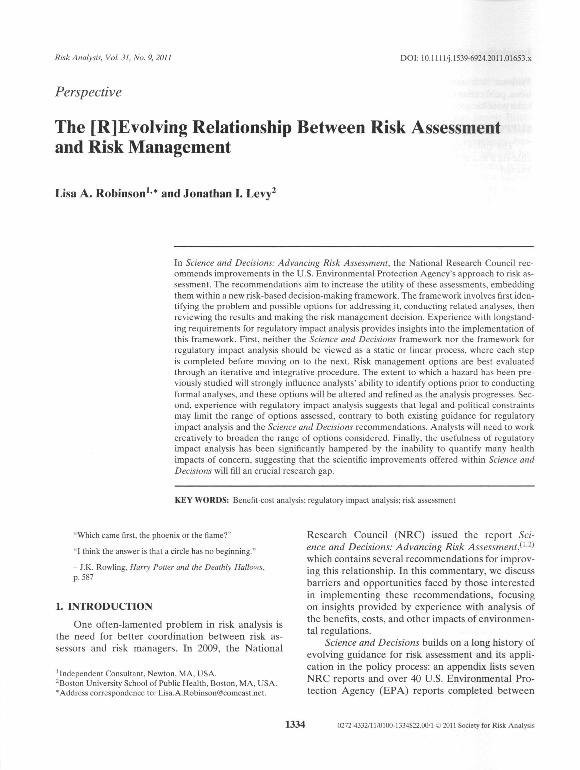The [R]Envilving relationship between risk assessment and risk management

Contenido multimedia no disponible por derechos de autor o por acceso restringido. Contacte con la institución para más información.
| Tag | 1 | 2 | Valor |
|---|---|---|---|
| LDR | 00000cab a2200000 4500 | ||
| 001 | MAP20110064402 | ||
| 003 | MAP | ||
| 005 | 20111103132008.0 | ||
| 008 | 111102e20110901esp|||p |0|||b|spa d | ||
| 040 | $aMAP$bspa$dMAP | ||
| 084 | $a7 | ||
| 100 | 1 | $0MAPA20110022938$aRobinson, Lisa A. | |
| 245 | 0 | 4 | $aThe [R]Envilving relationship between risk assessment and risk management$cLisa A. Robinson, Jonathan I. Levy |
| 520 | $aIn Science and Decisions: Advancing Risk Assessment, the National Research Council recommends improvements in the U.S. Environmental Protection Agency's approach to risk assessment. The recommendations aim to increase the utility of these assessments, embedding them within a new risk-based decision-making framework. The framework in vol ves first identifying the problem and possible options for addressing it, conducting related analyses, then reviewing the results and making the risk management decision. Experience with longstanding requirements for regulatory impact analysis provides insights into the implementation of this framework. First, neither the Science and Decisions framework nor the framework for regulatory impact analysis should be viewed as a static or linear process, where each step is completed befare moving on to the next. Risk management options are best evaluated through an iterative and integrative procedure. The extent to which a hazard has been previously studied will strongly influence analysts' ability to identify options prior to conducting formal analyses, and these options will be altered and refined as the analysis progresses. Second, experience with regulatory impact analysis suggests that legal and political constraints may limit the range of options assessed, contrary to both existing guidance for regulatory impact analysis and the Science and Decisions recommendations. Analysts will need to work creatively to broaden the range of options considered. Finally, the usefulness of regulatory impact analysis has been significantly hampered by the inability to quantify many health impacts of concern, suggesting that the scientific improvements offered within Science and Decisions will fill an crucial research gap. | ||
| 650 | 1 | $0MAPA20080591182$aGerencia de riesgos | |
| 650 | 1 | $0MAPA20080613099$aAnálisis costo-beneficio | |
| 650 | 1 | $0MAPA20080588953$aAnálisis de riesgos | |
| 700 | $0MAPA20080663360$aLevy, Jonathan I. | ||
| 773 | 0 | $wMAP20077000345$tRisk analysis : an international journal$dMcLean, Virginia : Society for Risk Analysis, 1987-2015$x0272-4332$g01/09/2011 Tomo 31 Número 9 - 2011 , p. 1334-1450 |

